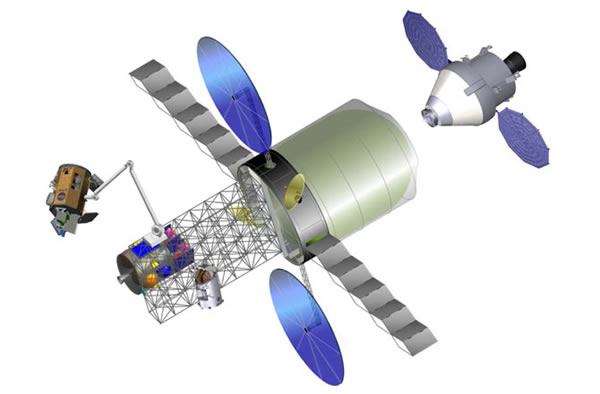Skylab II: Living beyond the Dark Side of the Moon
During the 1970s, Skylab was NASA’s first space station, built out of a fuel tank from a Saturn V rocket, one of NASA’s standard launch vehicles at the time. NASA’s advanced concepts office is now wondering if they could use the same trick again to launch the first ever outpost in deep space.
Brand Griffin, an engineer with Gray Research Inc working with NASA Marshall, certainly thinks so. Skylab II would be the first deep space station ever launched, to be parked in the Earth-Moon L2 (EML2) Lagrange point – a gravitationally stable point in space roughly 60,000 km from the dark side of the Moon, placing it a total of 440,000 km from Earth. This would truly be, to use a well known phrase, where no one has gone before.
When the original Skylab was launched, sitting atop the most powerful rocket ever constructed, it seemed an unusual idea. Instead of being a typical rocket payload, the station was actually built inside the uppermost rocket fuel tank. After being hoisted into orbit, any remaining hydrogen fuel was simply vented, leaving an uncrewed space station ready for use. As it happens, it turned out to be a very successful idea.
Skylab II: Living beyond the Dark Side of the Moon
Griffin’s concept uses the proposed Space Launch System (SLS) rocket instead of the Saturn V, but other than that, the procedure is practically identical. The SLS is already being developed to open the door for crewed missions into deep space, with destinations including Mars and nearby asteroids. NASA hopes to run SLS test flights by 2017, and plans are currently for it to start launching crewed missions by 2021.
If the plan goes ahead, Skylab II will certainly be spacious. The upper tank which the space station would be derived from is planned to have a diameter of 8.5 meters, giving it a volume of 495 cubic meters. This is nearly double the size of the modules which currently make up the ISS. This would give any of Skylab II’s inhabitants plenty of living space, and help to avoid the clutter which can sometimes be a problem on the ISS.
Being the first space habitat beyond lunar orbit, this would be a very different place to the ISS. There would be no quick way to return from here, and resupplying it would be costly and infrequent. Any astronauts staying there would be very much on their own for much of the time, and would need to solve problems by themselves. Even simple communications could be problematic on account of there being a Moon in the way!
While it has to be remembered that all of this is still simply a concept and little more, Griffin has detailed plans on how the Skylab II mission would unfold – presented recently at a meeting of the Future In Space Operations working group. Alongside the benefits of the station itself, Griffin presented a host of other details and concepts, including a “jumbo logistics module.” Also derived from a SLS fuel tank, this over-sized supply ship could be transported to EML2 to completely restock and refurnish Skylab II in one go.
Whether or not Skylab II goes ahead, a deep space outpost would be a valuable step in human spaceflight. Such an outpost could act as a rendezvous point for missions to the moon, and a stopover on the way to locations further afield. A human presence in deep space would also facilitate servicing missions to space observatories. With all the newest generation of space telescopes being sent further and further afield, a deep space outpost could enable upgrades and repair missions like those which have helped to keep the Hubble telescope going for so long.
Ever since the Apollo missions, no human being has traveled more than a few hundred kilometers away from the surface of our planet. It’s inspiring to see that people are still making plans and drawing up ideas to help keep us reaching further out into space.
Apr 14, 2013 07:36 AM ET by Markus Hammonds












